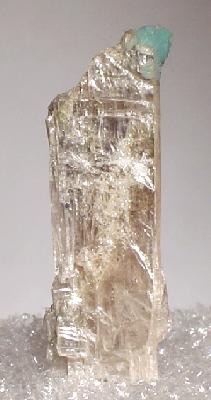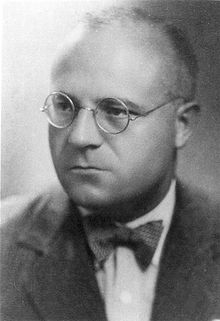Stranskiit
| Stranskiit | |
|---|---|
| Cyan-blue crust made of microcrystalline stranskiit on pearly white conductor (step size: 2.4 cm × 0.9 cm × 0.5 cm) | |
| General and classification | |
| chemical formula |
|
|
Mineral class (and possibly department) |
Phosphates, arsenates and vanadates |
|
System no. to Strunz and to Dana |
8.AB.35 ( 8th edition : VII / A.09) 03.38.07.01 |
| Similar minerals | Langite, Linarite, Devillin, Schultenite, Keyite |
| Crystallographic Data | |
| Crystal system | triclinic |
| Crystal class ; symbol | triclinic pinacoidal; 1 |
| Space group | P 1 (No. 2) |
| Lattice parameters |
a = 5.08 Å ; b = 6.69 Å; c = 5.30 Å α = 110.2 °; β = 112.1 °; γ = 86.7 ° |
| Formula units | Z = 1 |
| Physical Properties | |
| Mohs hardness | 4th |
| Density (g / cm 3 ) | 5.23 to 5.30 (measured); 5.00 to 5.10 (calculated) |
| Cleavage | completely after {010}, good after {100}, indicated after {001} and { 1 01} |
| colour | cyan, white |
| Line color | probably light blue |
| transparency | translucent to translucent |
| shine | high gloss |
| Crystal optics | |
| Refractive indices |
n α = 1.795 n β = 1.842 n γ = 1.874 |
| Birefringence | δ = 0.079 |
| Optical character | biaxial negative |
| Axis angle | 2V = 76 ° (calculated), 80 ° (measured) |
Stranskiit is a very rarely occurring mineral from the mineral class of " phosphates , arsenates and vanadates ". It crystallizes in the triclinic crystal system with the chemical composition CuZn 2 [AsO 4 ] 2 and is chemically a copper - zinc - arsenate .
Stranskiit develops tabular crystals which can come together to form radial aggregates up to 1 cm in size.
Etymology and history
As the discoverer of Stranskiits Hugo Strunz true that the mineral in 1957 on the 30th floor "in 1000 m depth has discovered the Tsumeb mine in SW Africa and collected." Corresponding investigations led to the determination of the presence of a new mineral , which a short time later, in 1960, Hugo Strunz described in a short article as Stranskiite. The mineral was named after the Bulgarian physical chemist and director of the Institute for Physical Chemistry at the Technical University of Berlin Professor Iwan Nikolow Stranski (1897–1979), who also became known as the "father of crystal growth research" and co-founder of the Kossel-Stranski theory .
Type material of the mineral is kept at the Technical University of Berlin (holotype, collection no. 86/63, 86/64 and 88/14 at location 25-9).
classification
Already in the outdated, but partly still in use 8th edition of the mineral classification according to Strunz , the stranskiite belonged to the mineral class of "phosphates, arsenates and vanadates" and there to the division of "anhydrous phosphates [PO 4 ] 3− , without foreign anions", where together with lammerite and xanthiosite, it formed the unnamed group VII / A.09 .
The 9th edition of Strunz's mineral systematics , which has been in effect since 2001 and is used by the International Mineralogical Association (IMA), also assigns the stranskiit to the category of “phosphates etc. without additional anions; without H 2 O “. However, this is further subdivided according to the relative size of the cations involved , so that the mineral can be found according to its composition in the sub-section “With medium-sized cations”, where the “Stranskiitgruppe” with the system no. 8.AB.35 and the only other member Mcbirneyit forms.
The systematics of minerals according to Dana , which is mainly used in the English-speaking world , assigns the Stranskiit to the class of "phosphates, arsenates and vanadates" and there in the department of "water-containing phosphates etc.". Here he is the only member of the unnamed group 03/38/07 within the subdivision of " Anhydrous phosphates etc., (A + B 2+ ) 3 (XO 4 ) 2 ".
Chemism
Stranskiit has the measured composition (Zn 1.73 Ca 0.10 Mg 0.09 Fe 0.05 ) Σ = 1.97 Cu 1.07 [(As 0.95 Si 0.05 ) Σ = 1.00 O 4 ] 2 , which can be simplified as Zn 2 Cu [AsO 4 ] 2 and requires 34.47% ZnO, 16.85% CuO and 48.68% As 2 O 5 .
Crystal structure
Stranskiite crystallizes in the triclinic crystal system in the space group P 1 (space group no. 2) with the lattice parameters a = 5.08 Å ; b = 6.69 Å; c = 5.30 Å; α = 110.2 °; β = 112.1 ° and γ = 86.7 ° and one formula unit per unit cell .
In the crystal structure of Stranskiits chains arranged offset parallel tetragonal Cu [010] [4 + 2] - dipyramids and dimers of two corner-sharing trigonal Zn [3 + 2] -Dipyramiden by AsO 4 - tetrahedra linked to a scaffold. The structure can also be described as a framework of six-ZnO 5 -AsO 4 rings, which are linked to one another by Cu dipyramids.
properties
morphology
Stranskiit develops tabular crystals which can come together to form radial aggregates up to 1 cm in size. Furthermore, the mineral occurs massively in the form of several millimeters thick coverings and centimeter wide in up, hyb euhedral ago grains that fill the voids decomposition of the primary ore mostly complete.
physical and chemical properties
The crystals of the Stranskiit are cyan blue or white. The line color is not specified, but the powder color of the cyan-blue crystals should be light blue, while that of the white crystals is also white. The surfaces of the translucent to transparent crystals have a strong gloss , which is also described as glass gloss.
The mineral has three different fissile properties . It splits completely after {010}, good after {100} and indistinctly after {001} and { 1 01}. With a Mohs hardness of 4, Stranskiite is one of the medium-hard minerals that, like the reference mineral fluorite, can be easily scratched with a pocket knife. The measured density of the mineral is 5.23 g / cm³, its calculated density is between 5.00 and 5.10 g / cm³, depending on the author.
Education and Locations
As a very rare mineral formation, stranskiite could only be described from a few sites. So far (as of 2016) only seven sites are known. The type locality is the world-famous Cu-Pb-Zn-Ag-Ge-Cd deposit of the "Tsumeb Mine" (Tsumcorp Mine) in Tsumeb , Oshikoto region , Namibia , where stranskiite was first found on the 30th level on Chalkosin. In 1976, a step with Stranskiit on the 31st level of the E 9 Pillar was recovered in the Tsumeb Mine. Stranskiite was found in millimeter to centimeter-sized inclusions in the massive tennantite , while galena and other arsenates such as adamin , olivite and schultenite appeared as accompanying minerals . Another find with stranskiit was made in the Tsumeb Mine in June 1994 at the 45th level. Stranskiit sat in the form of white (!) Aggregates on a blue (!) Mineral, which was recognized as the K-Ca- (Cu, Zn) -As phase, has the working name GS3 and has not yet been fully determined.
Stranskiit is a typical secondary mineral and (lower) formed in the second oxidation zone in dolomite stones seated hydrothermal polymetallic ore deposit Tsumeb from copper- and zinc-containing sulphides. Stranskiite is sometimes fused with warikahnite in colorless to pale yellow aggregates and with colorless to white coritnigite or claudetite . In addition to the mentioned minerals, angelsite , bayldonite , cuproadamine , keyite , ludlockite , tsumcorite , fragranceite , carminite , beudantite , scorodite , O'Danielite , zinc roselite and leiteitite were identified as parageneseminerals in Tsumeb .
In addition to the Tsumeb mine Stranskiit is still out of the pit Friedrichssegen in Lahnstein near Bad Ems , Rhein-Lahn-Kreis , Rheinland-Pfalz , Germany , from the Kramstollen at Maukenötz in the area Schwaz - Brixlegg in the Inn valley , Tyrol , Austria , and the territory of Kukhi-Malik near Ravat on the Jagnob River , Zeravshan Mountain Range, Viloyati (Province) Sughd in Tajikistan . In addition, Stranskiit has been identified at three German slag discovery sites. These include the slag deposits at the former zinc smelter Genna near Letmathe - Iserlohn , Sauerland , North Rhine-Westphalia , the slag discovery site at Schlackental near Oberschulenberg , Altenau-Schulenberg in the Upper Harz Mountains and the slag discovery site at the Silberhütte in Altenau , both in the Goslar district , Harz .
use
Due to its rarity, stranskiite is only of interest to mineral collectors. However, there is often confusion with visually similar minerals such as langite, linarite, devillin and schultenite. Confusions have also occurred with Keyit, but stranskit is only rarely associated with Adamin-Olivenit and occurs in larger grains, which have a pronounced cleavage.
See also
literature
- C. Calvo, KY Leung (1969): Refinement of the crystal structure of stranskiite. In: Zeitschrift für Kristallographie , Volume 130, pp. 231–233 ( PDF, 102 kB ).
- Henry A. Hänni, Willem B. Stern, Martin Glor (1978): New data on stranskiite from Tsumeb, Namibia. In: American Mineralogist , Volume 63, pp. 213-215 ( PDF, 243 kB ).
- Paul Keller, Heinz Hess, Pete J. Dunn (1979): The charge balance for a refined crystal structure of stranskiite, Zn 2 Cu (AsO 4 ) 2 . In: Tschermaks Mineralogische und Petrographische Mitteilungen , Volume 26, pp. 167–174.
- K. Plieth, G. Singer (1967): The Structure of the Stranskiits Zn 2 Cu (AsO 4 ) 2 . In: Zeitschrift für Kristallographie , Volume 124, pp. 91-100 ( PDF, 403 kB ).
- Hugo Strunz (1960): Stranskiite, a new mineral. In: Die Naturwissenschaften , Volume 47 (No. 16), p. 376.
- Stranskiit , In: John W. Anthony, Richard A. Bideaux, Kenneth W. Bladh, Monte C. Nichols (Eds.): Handbook of Mineralogy, Mineralogical Society of America , 2001 ( PDF, 65 kB ).
Web links
- Mineral Atlas: Stranskiit (Wiki)
- Mindat - Stranskiit
- Webmineral - Stranskiit
- American-Mineralogist-Crystal-Structure-Database - Stranskiit
Individual evidence
- ↑ a b c d e f g Hugo Strunz , Ernest H. Nickel : Strunz Mineralogical Tables . 9th edition. E. Schweizerbart'sche Verlagbuchhandlung (Nägele and Obermiller), Stuttgart 2001, ISBN 3-510-65188-X , p. 429 .
- ↑ a b c d e f g h i j k l m n o p q Hugo Strunz (1960): Stranskiit, a new mineral. In: Die Naturwissenschaften , Volume 47 (No. 16), p. 376.
- ↑ a b c d e f g h i j Stranskiit , In: John W. Anthony, Richard A. Bideaux, Kenneth W. Bladh, Monte C. Nichols (Eds.): Handbook of Mineralogy, Mineralogical Society of America , 2001 ( PDF, 65 kB ).
- ↑ a b c d e Georg Gebhard: Tsumeb . 1st edition. GG Publishing, Grossenseifen 1999, p. 258-259 .
- ↑ Type mineral catalog Germany - storage of the holotype stage Stranskiit
- ↑ a b c Paul Keller (1977): Tsumeb / Namibia - one of the most spectacular mineral discovery sites on earth. In: Lapis , Volume 9 (Issue 7/8), pp. 13–63.
- ↑ Mindat - Number of localities for Stranskiit
- ↑ Find location list for Stranskiit at the Mineralienatlas and at Mindat
- ^ Henry A. Hänni, Willem B. Stern, Martin Glor (1978): New data on stranskiite from Tsumeb, Namibia. In: American Mineralogist , Volume 63, pp. 213-215 ( PDF, 243 kB ).
- ↑ Georg Gebhard: Tsumeb . 1st edition. GG Publishing, Reichshof 1991, p. 180-181 .
- ^ Ludi von Bezing, Rainer Bode, Steffen Jahn: Namibia. Minerals and sites (Edition Schloss Freudenstein) . 1st edition. Bode-Verlag, Haltern 2007, ISBN 978-3-925094-88-0 , p. 787 .


